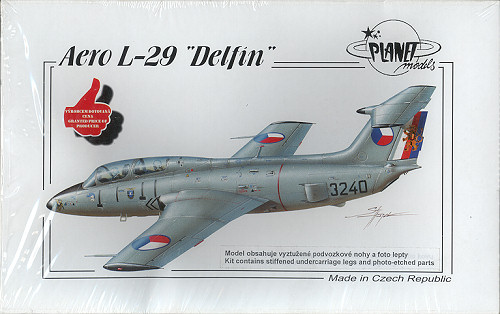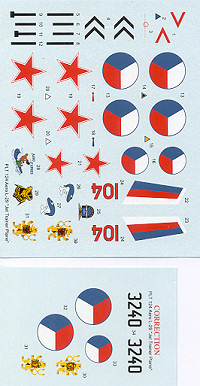
| KIT: | Planet Models 1/48 L.29 'Delfin' |
| KIT #: | 124 |
| PRICE: | $49.50 MSRP |
| DECALS: | Two options |
| REVIEWER: | Scott Van Aken |
| NOTES: | Resin kit with vacuformed canopies |

| HISTORY |
The prototype of the L-29 Delfin ("Dolphin") trainer, first flew in Czechoslovakia on 5 April 1959, powered by a Bristol Siddeley Viper turbojet engine. The second prototype, first flown in July 1960, was powered by the Czech-designed M701 engine, a power plant that was to power all the others in the series. The development of the prototype was due to a Soviet requirement for a jet trainer to replace the MiG-15 UTI so money was provided to Aero for this purpose.
The L-29 was entered into a competition against the Russian Yakovlev Yak-30 and the Polish TS-11 Iskra. The L-29 won and subsequently became the standard trainer nearly all of the Soviet sphere of influence. The Poles decided not to accept the results and developed their TS-11 Iskra for home use. This aircraft was later developed into a single seat light attack aircraft.
The first production Delfin rolled off the assembly line in April 1963, and production continued for more than 11 years, a relatively long time for a singular design, though by no means uncommon, especially when one considers that some aircraft, such as the C-130 and F-16 have been in production for decades. Of the over 3,500 built, more than 2,000 were eventually supplied to the Soviet air force, and 400 more to the Czech air force. Others were supplied to Bulgaria, East Germany, Hungary, Romania and other air forces friendly to the Soviet Union such as Libya, Vietnam and others.
The L-29 was ideal as both a primary jet trainer and as an advanced combat/weapons trainer and while a small number of a single-seat versions outfitted as light attack were built as the L-29A, it never caught on. As with many trainer types, following the fall of communism, countries were left with aircraft they could not afford to maintain and operate so many L-29s have been sold off to warbird enthusiasts. Thanks to their rugged construction, basic avionics and generally simple systems, they are quite popular.
| THE KIT |
 Planet
Models has always had a reputation for producing quality resin kits. These kits
are generally free from the usual air bubbles, chipped areas where the resin
flows into the part, those small resin balls that hide inside intakes or wheel
wells, and the surface blemishes that plague some other kits.
Planet
Models has always had a reputation for producing quality resin kits. These kits
are generally free from the usual air bubbles, chipped areas where the resin
flows into the part, those small resin balls that hide inside intakes or wheel
wells, and the surface blemishes that plague some other kits.
This one is no exception and though I've not removed the parts from the bags to photograph them (as much to prevent part loss and damage as anything else, I can tell you that aside from some flash and rather hefty pour stub attachment areas, the resin is free from glitches. There is considerable wheel well and cockpit detail molded into the parts; in the case of the latter, there is detail in the tub as well as the inside of the fuselage. Damage to the smaller parts is quite limited, thanks to the packaging.
In order to assure no tail sitting problems, a large weight into which the cockpit sits, is provided. To be sure that the struts won't collapse under all this mass, they have been reinforced, probably with wire. Photo-etch is limited to the instrument panel faces and film is provided with the instruments themselves to be sandwiched in between the panel face and the backing plate. Two nicely done vacuformed canopies are included so that one has a spare in case of a goof or on the off chance that the builder wants to cut them to show an open cockpit. The open cockpit configuration of these parts is provided in the instructions. One can also show the speed brakes open if that is desired.
 Instructions
are on two sheets with printing on both sides. One sheet is dedicated to parts
layout and the 18 nicely drawn construction steps. No color information is
supplied for interior or wheel wells. There are some notes on differences
between a 'version a' and 'version b', the A version being the Czech aircraft.
The other sheet is a painting and markings guide. Two aircraft are shown, one a
Russian aircraft in aluminum with red or black areas. Unfortunately, the
greyscale markings for red and black are identical so one cannot tell which is
to be used where. The other is for a Czech aircraft in overall light grey (no FS
595 recommendation) with black tips to the nose, wings, stab and intakes. The
decals are well printed and it appears that Planet initially forgot that the
Czech insignia are handed as an addendum sheet is provided to fix this. Rather
odd for a Czech company! The L.39 flew with a number of other countries so
some research should be able to turn up some other possibilities aside from what
the kit supplies.
Instructions
are on two sheets with printing on both sides. One sheet is dedicated to parts
layout and the 18 nicely drawn construction steps. No color information is
supplied for interior or wheel wells. There are some notes on differences
between a 'version a' and 'version b', the A version being the Czech aircraft.
The other sheet is a painting and markings guide. Two aircraft are shown, one a
Russian aircraft in aluminum with red or black areas. Unfortunately, the
greyscale markings for red and black are identical so one cannot tell which is
to be used where. The other is for a Czech aircraft in overall light grey (no FS
595 recommendation) with black tips to the nose, wings, stab and intakes. The
decals are well printed and it appears that Planet initially forgot that the
Czech insignia are handed as an addendum sheet is provided to fix this. Rather
odd for a Czech company! The L.39 flew with a number of other countries so
some research should be able to turn up some other possibilities aside from what
the kit supplies.
| CONCLUSIONS |
I'm sure this one will be as delightful a build as have other Planet Model kits I've done over the years. It is an interesting subject and looks to be a much nicer build than the MPM L.39 done a year or so back. It would be perfect as an intermediate resin build so if you are at that stage, this is a kit you should consider.
March 2006
Review kit courtesy of me and haggling with vendors.
If you would like your product reviewed fairly and quickly by a site that has over 300,000 visitors a month, please contact me or see other details in the Note to Contributors.